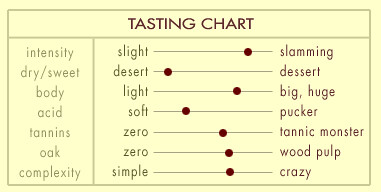“The wine is described well.” he says about one of the reviews, “I have a connection to the wine through culture and art, I have context, I clearly understand the individuality of the wine and I'm entertained just by reading the review. Oh, and I want to buy it.”
But then, in The Total Fantasy of Wine Ratings, Mark Fisher at Wine Sediments questions the validity of wine ratings and tasting notes:
“With a wine of that production level [200,000 cases],” he wonders, “it's a damn sure bet that no matter how much blending Falesco does, there is not ONE SINGLE DROP of wine in the two-millionth bottle that comes off the production line that has much of ANYTHING in common in terms of vineyard site, clonal selection, picking time, etc. to the FIRST bottle that came off that production line, and which, for the sake of argument, was the bottle reviewed by the Wine Spectator. So why in the world would we give any credence whatsoever to what the wine's score was in the Wine Spectator, or Parker, or Decanter, or (shudder) even Wine Sediments?”
Furthermore, in Do Ratings Rate?, Eric Asimov at The Pour shares his mixed feelings about ratings:
“First of all, they can be valuable to consumers” he says, “For $100 a bottle, or $40, or even $20, people want to increase the odds that they are going to like what they pay for, and that's why ratings are useful.” But then he adds: “Tasting notes are among the least useful of all consumer aids. They offer the illusion of description, but really tell you very little about a wine.”
I also have mixed feelings about wine ratings and tasting notes. Tasting notes are very personal and have therefore far less significance to other people. I have also noticed substantial bottle to bottle variations: some wines that I had greatly enjoyed one day had disappointed me later with another bottle. On the other hand, tasting notes and ratings can be really helpful when you don't know the wine. Some tasting notes just compel you to buy it.
Now, while browsing the Tulip Hill Winery website, I recently discovered a tasting chart that, I think, is great at assessing wine quality and style. For instance, here is the tasting chart for the 2001 Tulip Hill Cabernet Sauvignon Napa Valley:

In addition to the chart, the winery also provides the following tasting notes: “A big wine, with dense blackberry, licorice and tobacco aromas, adding damp earth and violets to produce a rich yet delicate nose. Complex flavors of dark cherry, raspberry, cigar box, and dried fennel blend nicely with the toasty oak. Velvety tannins give exquisite texture and body, and a finish which borders on endless.”
So which do you think is more instructive? I would love to see these charts on shelf takers and also on restaurant wine lists. Isn't pairing a wine with food highly dependent on whether this wine is sweet, dry, acid and/or tannic?
Technorati tags: wine food & drink
No comments:
Post a Comment